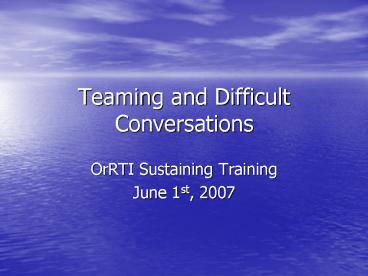Teaming and Difficult Conversations PowerPoint PPT Presentation
Title: Teaming and Difficult Conversations
1
Teaming and Difficult Conversations
- OrRTI Sustaining Training
- June 1st, 2007
2
Five Characteristics
Results
Accountable
Commitment
Conflict Capable
Trust
3
Trust
- What are issues that your team might encounter
that are based on trust.
4
Conflict Capable
- What experiences has your team had that have
tested your conflict capability? - What skills did someone use to address the
conflict?
5
Commitment
- Has your team identified its purpose?
- Does the team represent stakeholders in the
school? - Is there commitment to
- The team itself?
- To the teams purpose (children)?
6
Accountable
- Is there a clear agenda and purpose for each
meeting? - Is the role of each person defined?
- When preparation is required, is it complete for
the meeting? - Is there a mechanism for fixing accountability
problems? - Does the team take responsibility for maintaining
itself?
7
Results
- Does the team get to the core of its purpose and
evaluate outcomes? - Does the team encourage, plan, and celebrate
together?
8
How Teams Go South
- Meetings
- Communication
- Teamwork
- Decision-making
- Handling conflict
9
Critical Elements for Meetings
- Purpose
- Attention to structure
- Agenda
- Topic outcomes
- Content vs. process
- Clarity about meeting roles
- Meeting closure
10
Decision Making
- Know your desired outcomes
- Stakeholder buy-in, time frames
- Level of decision-making needed to reach desired
outcome - Frame problems broadly
- Set criteria for evaluating options
- Separate generating options from judging options
- Have back-up strategies if agreement is elusive
(for consensus decisions)
11
A communication strategy
- DARE
- Data (I notice. . .)
- Assumptions (I think it must be that. . .)
- Reaction (I feel. . .)
- Expectations (I bring this up so that. . .)
PowerShow.com is a leading presentation sharing website. It has millions of presentations already uploaded and available with 1,000s more being uploaded by its users every day. Whatever your area of interest, here you’ll be able to find and view presentations you’ll love and possibly download. And, best of all, it is completely free and easy to use.
You might even have a presentation you’d like to share with others. If so, just upload it to PowerShow.com. We’ll convert it to an HTML5 slideshow that includes all the media types you’ve already added: audio, video, music, pictures, animations and transition effects. Then you can share it with your target audience as well as PowerShow.com’s millions of monthly visitors. And, again, it’s all free.
About the Developers
PowerShow.com is brought to you by CrystalGraphics, the award-winning developer and market-leading publisher of rich-media enhancement products for presentations. Our product offerings include millions of PowerPoint templates, diagrams, animated 3D characters and more.

